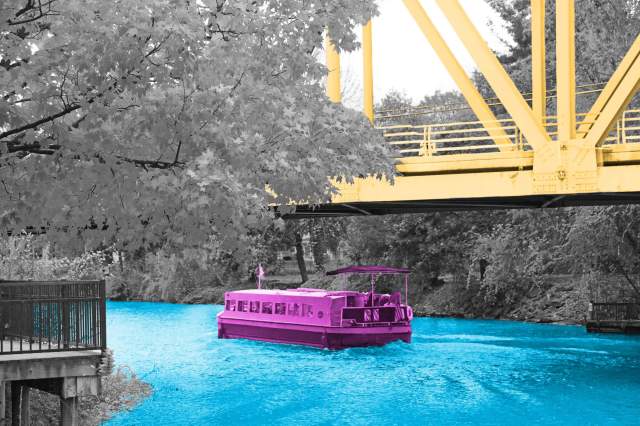
A Prisoner Inspired the Creation of the Erie Canal
New York flour merchant Jesse Hawley knew a thing or two about the challenges of transporting goods across the state’s decrepit roads, as his difficulties in that endeavor landed him in debtors’ prison by 1807. Frustrated but not defeated, Hawley went on to write a series of essays, published in the Genesee Messenger under the pseudonym “Hercules,” in which he argued for the creation of a cross-state canal to improve transportation efficiency. Although the idea wasn’t exactly novel — other American canals had already been completed by that point — Hawley’s writing drew attention for his detailed explanations of a proposed pathway, the costs, and the potential benefits, and he is largely credited with inspiring influential lawmakers to take up the cause.

New York Politician DeWitt Clinton Shepherded the Canal Into Reality
If Hawley provided the spark to ignite the appeal of a canal across New York, then powerful politician DeWitt Clinton fanned the flames into a full-blown conflagration. The three-term New York City mayor joined the state’s Canal Commission in 1810, and as the group’s commissioner he orchestrated a formal petition to the New York Legislature that led to a $7 million allocation for the project in April 1817. Three days after Clinton took office as New York governor, the canal’s construction commenced on July 4, 1817. Although the massive undertaking was in turns derided as “Clinton’s ditch” or “Clinton’s folly,” the governor had the last laugh when he rode the packet boat Seneca Chief eastward across the completed canal in the fall of 1825, and commemorated his triumph by pouring two casks of Lake Erie water into the Atlantic Ocean in the “Wedding of the Waters.”

No Professionally Trained Engineers Worked on the Project
After English engineer William Weston declined the offer to oversee construction, the New York Canal Commission selected four men — Benjamin Wright, James Geddes, Charles Broadhead, and Nathan S. Roberts — with surveying backgrounds and zero formal engineering training to serve as the Erie Canal’s chief engineers. Amazingly, these four guided the project to completion through trial and error and help from a talented supporting cast. Assistant engineer Canvass White, who had studied some of Europe’s canal systems, perfected a locally developed hydraulic cement. Another young surveyor named John Jervis proved to have remarkable abilities that would turn him into one of the country’s premier engineers. Together, the team came up with innovations like the Irondequoit Embankment and the “Flight of Five” double locks that enabled the steep ascent at the Niagara Escarpment. Given all the lessons learned on the fly, and the influence these men had on subsequent construction projects in the country, historians have dubbed the process of creating the Erie as America’s first school of engineering.
More Interesting Reads

The Erie Canal Triggered a Population Explosion Along Its Path
Evidence of the canal’s contributions to the development of New York into the booming Empire State was reflected in the rapid population growth along the canal’s banks. Buffalo expanded from a population of 2,400 in 1825 to 8,700 by 1830; Syracuse jumped from 1,000 in 1825 to 22,300 by 1850; and Rochester went from 9,200 in 1830 to 48,200 by 1860. And while there were certainly other factors involved, New York City went from a population of 125,706 in 1820 to 515,547 in 1850. Even today, more than 70% of residents of upstate New York live within 25 miles of the Erie Canal.

Numerous Songs Have Been Written About the Canal
From the performance of Samuel Woodworth’s “The Meeting of the Waters of Hudson & Erie” at the canal’s grand opening in 1825, the New York waterway has served as an inspiration for a legion of musicians and songwriters. Some songs, like George M. Cohan’s “Down by the Erie Canal,” were crooned on a Broadway stage. Others, like Henry Russell’s “A Life on the Raging Canal,” were Weird Al Yankovic-type parodies of existing popular songs. Still others, such as “A Trip on the Erie,” emerged from anonymous origins and endured among the canallers who spent most of their time on the slow-moving waters. Regardless, the canal’s most famous song is surely “Low Bridge, Everybody Down,” aka “Fifteen Years on the Erie Canal.” Credited to Tin Pan Alley writer Thomas S. Allen circa 1912, the ditty has since been covered by luminaries such as Pete Seeger and Bruce Springsteen.

The Canal Has Undergone Dramatic Changes Over Two Centuries
Were DeWitt Clinton to step onto a time-traveling barge and arrive at the present-day Erie Canal, he’d notice a number of alterations to his pet project. Originally 40 feet wide and 4 feet deep, the canal was enlarged to dimensions of 70 feet across and 7 feet in depth by 1862, and expanded again to minimums of 125 feet wide and 12 feet deep by 1918. That later round of renovations also took advantage of engineering advancements to reroute the canal through existing bodies of water, leading to the abandonment of old checkpoints. Now part of the 524-mile New York State Canal System, which includes the Champlain, Oswego, and Cayuga-Seneca canals, the Erie no longer reaches the original eastern and western endpoints of Albany and Buffalo, and bypasses Syracuse altogether.

The Old Canal Still Hosts Commercial Traffic
After the Erie and its related canals experienced a peak of 5.2 million tons of cargo transported across its waters in 1951, the opening of the St. Lawrence Seaway hastened a commercial decline that brought that number below 50,000 tons by the 1990s. But while the NYS Canal System mainly sells itself as a tourist destination nowadays, rising fuel costs have again prompted some companies to seek a more efficient means of hauling goods across the old waterway. After reaching a 50-year low of just over 4,000 tons transported in 2009, the canal system bounced back to a more impressive haul of over 415,000 tons shipped in 2017.












